External links
| Borates | |||||
|---|---|---|---|---|---|
| Carbonates | |||||
| Oxides |
| ||||
| Phosphates | |||||
| Silicates | |||||
| Sulfides | |||||
| Other |
| ||||
| | This article about a specific silicate mineral is a stub. You can help Wikipedia by expanding it. |
Jeffersonite is a dark green pyroxene mineral, a manganese zinc enriched variety of augite, chemical formula Ca(Mn,Zn,Fe)Si
2O
6, sometimes compared to aegirine. Jeffersonite is not a recognized mineral name.
It occurs in pegmatites where it can form crystals up to 30 cm (12 in) long and in the contact metamorphic zone between limestone and various intrusive rocks. It is reported from the Sterling Hill Mine, Franklin, New Jersey, in South Australia and Sweden.
| | This article about a specific silicate mineral is a stub. You can help Wikipedia by expanding it. |

Mining is the extraction of valuable minerals or other geological materials from the Earth, usually from an ore body, lode, vein, seam, reef or placer deposit. These deposits form a mineralized commodity that is of economic interest to the miner.

Marl or marlstone is a carbonate-rich mud or mudstone which contains variable amounts of clays and silt. The term was originally loosely applied to a variety of materials, most of which occur as loose, earthy deposits consisting chiefly of an intimate mixture of clay and calcium carbonate, formed under freshwater conditions. These typically contain 35–65% clay and 65–35% carbonate. The term is today often used to describe indurated marine deposits and lacustrine (lake) sediments which more accurately should be named 'marlstone'.

Zincite is the mineral form of zinc oxide (ZnO). Its crystal form is rare in nature; a notable exception to this is at the Franklin and Sterling Hill Mines in New Jersey, an area also famed for its many fluorescent minerals. It has a hexagonal crystal structure and a color that depends on the presence of impurities. The zincite found at the Franklin Furnace is red-colored, mostly due to iron and manganese dopants, and associated with willemite and franklinite.
Sussexite is a manganese borate mineral MnBO2(OH). Crystals are monoclinic prismatic and typically fibrous in occurrence. Colour is white, pink, yellowish white with a pearly lustre. It has a Mohs hardness of 3 and a specific gravity of 3.12.
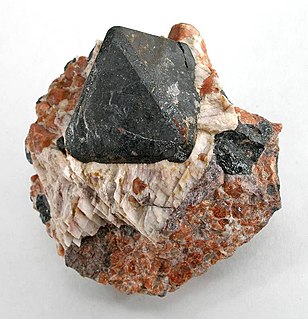
Franklinite is an oxide mineral belonging to the normal spinel subgroup's iron (Fe) series, with the formula ZnFe3+2O4.

Tephroite is the manganese endmember of the olivine group of nesosilicate minerals with the formula Mn2SiO4. A solid solution series exists between tephroite and its analogues, the group endmembers fayalite and forsterite. Divalent iron or magnesium may readily replace manganese in the olivine crystal structure.
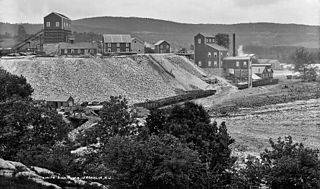
Franklin Furnace, also known as the Franklin Mine, is a famous mineral location for rare zinc, iron, manganese minerals in old mines in Franklin, New Jersey, United States. This locale produced more species of minerals and more different fluorescent minerals than any other location. The mineral association (assemblage) from Franklin includes willemite, zincite and franklinite.
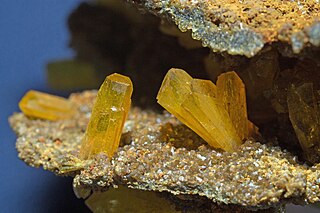
Legrandite is a rare zinc arsenate mineral, Zn2(AsO4)(OH)·(H2O).
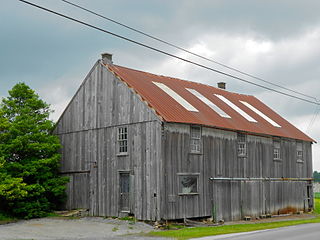
Nickel Mines is a hamlet in Bart Township, Lancaster County, Pennsylvania, USA. The area now has a sizable Amish community. The zip code is 17562 and the area code is 717.
New Jersey is a very geologically and geographically diverse region in the United States' Middle Atlantic region, offering variety from the Appalachian Mountains and the Highlands in the state's northwest, to the Atlantic Coastal Plain region that encompasses both the Pine Barrens and the Jersey Shore. The state's geological features have impacted the course of settlement, development, commerce and industry over the past four centuries.
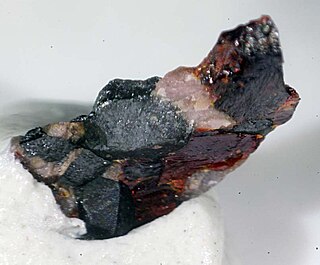
Jerrygibbsite is a rare silicate mineral with chemical formula: (Mn,Zn)9(SiO4)4(OH)2. Jerrygibbsite was originally discovered by Pete J. Dunn in 1984, who named it after mineralogist Gerald V. Gibbs (born 1929). It has only been reported from the type locality of Franklin Furnace, New Jersey, United States, and in Namibia's Otjozondjupa region. Jerrygibbsite is member of the leucophoenite family of the humite group. It is always found with these two minerals. It is a dimorph of sonolite.

Lardner Vanuxem, was an American geologist. He was graduated at the Ecole des mines, Paris, in 1819. After his education, he became the Chair of Chemistry and Mineralogy at South Carolina College in Columbia, South Carolina. In 1826 he retired from the college and devoted his attention exclusively to geology as a profession. During that year he published in newspapers and in Robert Mills' "Statistics of South Carolina" report on the geology of the state.

The Sterling Hill Mine, now known as the Sterling Hill Mine Tour & Museum of Fluorescence, is a former iron and zinc mine in Ogdensburg, Sussex County, New Jersey, United States. It was the last working underground mine in New Jersey when it closed in 1986, and it became a museum in 1989. Along with the nearby Franklin Mine, it is known for its variety of minerals, especially the fluorescent varieties. It was added to the National Register of Historic Places in 1991.
St. Joe Minerals Corporation was an American mining company. It was the United States largest producer of lead and zinc at the time of its merger with Fluor Corporation in 1981. The St. Joseph Lead Company was founded on March 25, 1864 by Lyman W. Gilbert, John E. Wylie, Edmund I. Wade, Wilmot Williams, James L. Dunham and James L. Hathaway in New York City.
The Franklin Mineral Museum in Franklin, New Jersey is a mineral, geology, and mining museum at the former Franklin Mine. It is located in Sussex County, New Jersey.

The Pahaquarry Copper Mine is an abandoned copper mine located on the west side of Kittatinny Mountain presently in Hardwick Township in Warren County, New Jersey in the United States. Active mining was attempted for brief periods during the mid-eighteenth, mid-nineteenth, and early twentieth centuries but was never successful despite developments in mining technology and improving mineral extraction methods. Such ventures were not profitable as the ore extracted proved to be of too low a concentration of copper. This site incorporates the mining ruins, hiking trails, and nearby waterfalls, and is located within the Delaware Water Gap National Recreation Area and administered by the National Park Service.
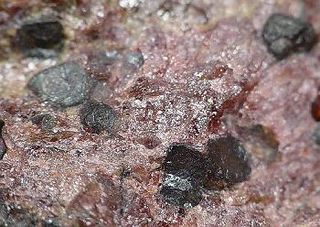
Sonolite is a mineral with formula Mn9(SiO4)4(OH,F)2. The mineral was discovered in 1960 in the Sono mine in Kyoto Prefecture, Japan. In 1963, it was identified as a new mineral and named after the Sono mine.

Leucophoenicite is a mineral with formula Mn7(SiO4)3(OH)2. Generally brown to red or pink in color, the mineral gets its name from the Greek words meaning "pale purple-red". Leucophoenicite was discovered in New Jersey, US and identified as a new mineral in 1899.

Charlesite is a sulfate mineral of the ettringite group. Charlesite was named in 1945 after Dr. Charles Palache mineralogist and professor at Harvard University for his work on minerals. This mineral is extremely rare, and when it is found it is often in crystal form. Its crystals are soft hexagonal, that can vary in color. Colors can range from clear to white, or even a pale yellow or pink. The brittle mineral's Mohs hardness is 2.5 with a specific gravity of 1.79. Though transparent to the eye the mineral has a white streak.